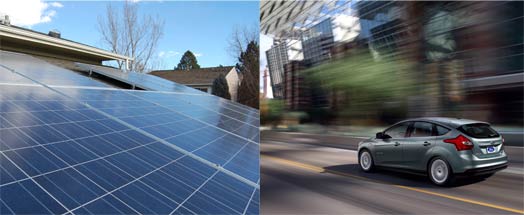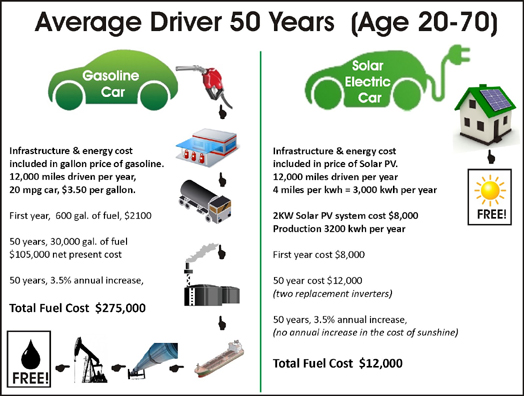
The answer to the question of how much money combining a home solar system with an electric vehicle can save you is complicated, though, as a wonderful graphic created by veteran solar-charged driver Peder Norby that we re-published a few days ago shows, on the surface it doesn’t have to be.
According to Norby’s calculations, a home solar fueling station is likely to save many people in the U.S. well over $200,000 over the course of 50 years [see graphic at the bottom of this entry].
That’s substantial savings, but, of course, it’s also across a long period of time.
That’s part of the problem with solar-charged driving. No, check that, that’s part of the problem with American society: We’re so fixated on the short-term that we can’t see the long-term. In fact, in many (most?) cases, including that of EV + PV, many of us refuse to see the long-term.
American short-sightedness
To be fair, in some ways, I can’t blame Americans for focusing on the short-term. After all, we haven’t bought an electric car yet because — you guessed it — in the short-term, we don’t have the money to do so. This, even though I know, in the long-term, it will save us money. [Our situation is pretty unique: Our household income may temporarily drop by 75% soon – but luckily for just one year.]
![A Nissan LEAF + a SunPower solar system [upper left on roof]. sunpower-nissan1](http://solarchargeddriving.com/wp-content/uploads/2011/11/sunpower-nissan1.jpg) But beyond the short-sightedness of America and Americans, there are other issues with Norby’s analysis. Norby’s fully aware of these, many of which are hard to compress into a neat graphic – it really is a great graphic – such as the one he produced.
But beyond the short-sightedness of America and Americans, there are other issues with Norby’s analysis. Norby’s fully aware of these, many of which are hard to compress into a neat graphic – it really is a great graphic – such as the one he produced.
One of the biggest issues is the variability in prices for solar systems in the U.S. thanks to large differences in local and state incentives. Many people might get the same, or better, price of $8,000 Norby estimates for a 2 kW system. However, more than a few will end up paying more.
Cost of gas vs. electric car
Norby also doesn’t include the cost of a new gasoline or electric vehicle in his calculations.
Right now, it’s clear that a new production EV costs substantially more than a comparable gasoline car. Take, for instance, the $18,000 difference in price between a $31,000 post Federal Tax Credit Nissan LEAF and $13,000 for a new Nissan Versa. [Again, as with solar PV, there’s huge variability in state incentives for EVs, so the Nissan LEAF could cost you quite a bit less out of pocket than $31,000, depending on where you live.]
There’s also the question of how long solar panels last. Norby estimates 50 years of life from the same panels. In fact, there is evidence solar PV panels could last that long. But they’re not guaranteed to.
Roof replacement on a solar roof
There’s another cost that Norby doesn’t address in his graphic – don’t get me wrong, I LOVE this graphic and the message of SAVINGS! it sends: The cost of roof replacement.
Our roof won’t last 50 years, even if our solar panels do. At best, our roof’s got another 20 years. At that point, our entire 26-panel, 5.59 kW solar system will have to be dismantled, a new roof laid, and the PV system re-installed on top of the new roof. I’m not sure how much this will cost – especially since we’re talking about 20 years from now – but it seems to me that it’s going to be at least an extra $2,000 to $3,000.
Alright, so let’s say we need to add in a few additional costs to Norby’s calculations, what does the 50-year savings look like then?
{googleAds}<div style=”float:right; margin-left: 10px;”>
<script type=”text/javascript”><!–
google_ad_client = “pub-7703542917199961”;
/* 200×200,
created 12/8/09 */
google_ad_slot = “7950368454”;
google_ad_width
= 200;
google_ad_height = 200;
//–>
</script>
<script
type=”text/javascript”
src=”http://pagead2.googlesyndication.com/pagead/show_ads.js”>
</script>
</div>
{/googleAds}
Let’s do the math –>
Norby’s original estimated savings of PV fuel for an EV over gasoline for a traditional car
= $263,000
– $54,000 based on buying three econo gas cars across 50 years vs. three EVs (Nissan Versa vs. LEAF)
– $5,000 for new 2 kW solar system at 30 years
– $3,000 for solar system un- and re-installation costs due to roof replacement at 25 years
= $201,000 in savings
Hmmm…even when you factor in the savings of three new gasoline cars vs. more expensive EVs (it’s pretty unclear if the big cost gap between new gas cars and production EVs will stay as high as it is right now), the cost of buying an entirely new set of solar panels (Norby already includes the cost of two solar inverter replacements), and the extra costs a solar PV system will cause when a new roof must be put on your house, you’re still looking at more than $200,000 in savings across 50 years.
Not shabby, not too shabby indeed!
Here’s Norby’s original graphic, BTW –>

Related articles–>


